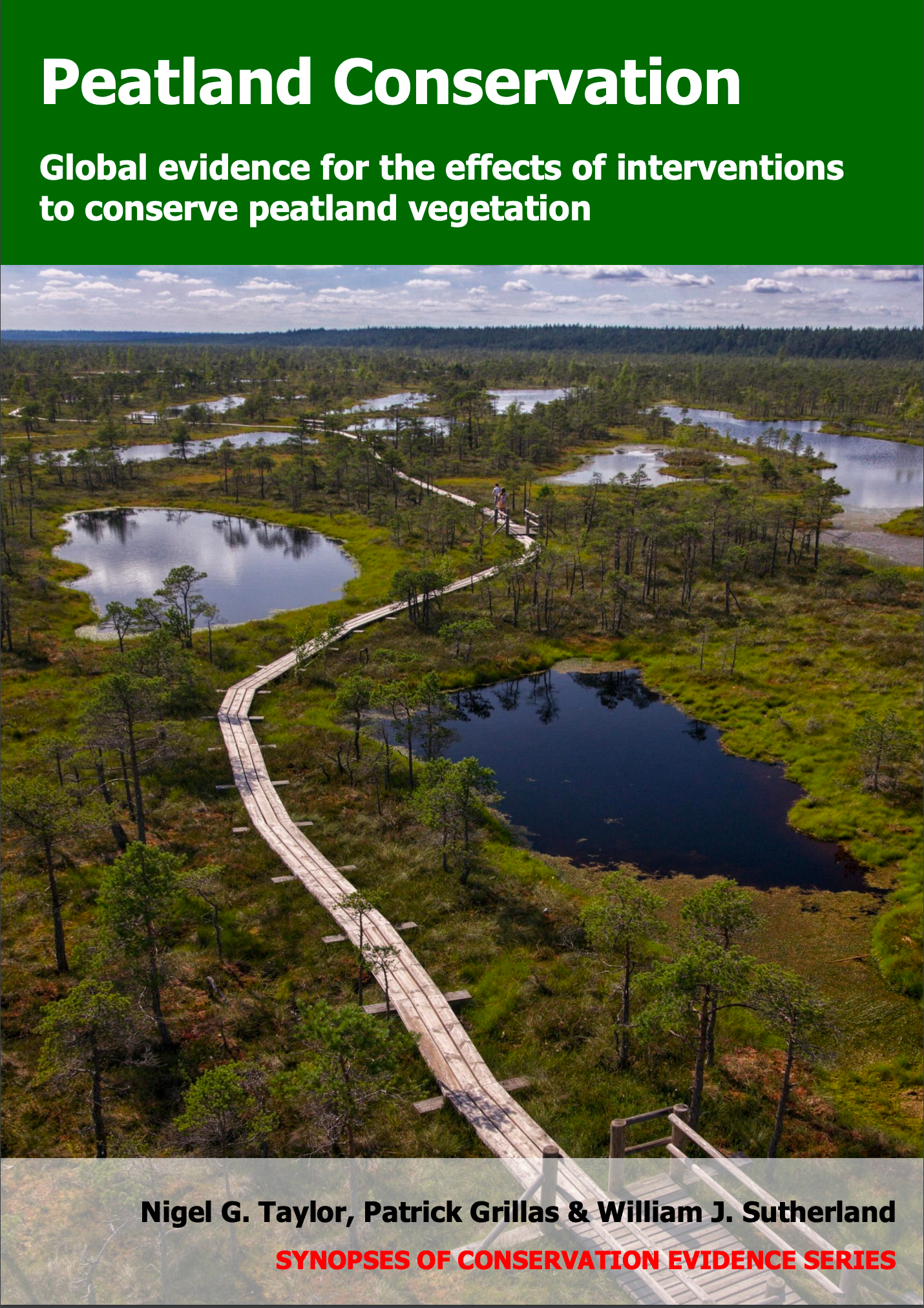Actions to conserve biodiversity
We have summarised evidence from the scientific literature about the effects of actions to conserve wildlife and ecosystems.
Review the evidence from the studies
Not sure what Actions are? Read a brief description.
Search for evidence
e.g. "frogs chytrid"
125 Actions found
Refine
Hide
125 Actions found
Download Actions
| 0 selected |
|
Order results by:
| Action | Effectiveness | Studies | Category | |
|---|---|---|---|---|
|
Cover peatland with organic mulch (after planting) Action Link |
Likely to be beneficial | 12 |
|
|
|
Cover peatland with something other than mulch (after planting) Action Link |
Likely to be beneficial | 8 |
|
|
|
Introduce nurse plants (to aid focal peatland plants) Action Link |
Unknown effectiveness (limited evidence) | 3 |
|
|
|
Rewet peatland (before/after planting) Action Link |
No evidence found (no assessment) | 0 |
|
|
|
Irrigate peatland (before/after planting) Action Link |
Unknown effectiveness (limited evidence) | 1 |
|
|
|
Reprofile/relandscape peatland (before planting) Action Link |
Likely to be beneficial | 4 |
|
|
|
Create mounds or hollows (before planting) Action Link |
Unknown effectiveness (limited evidence) | 3 |
|
|
|
Remove upper layer of peat/soil (before planting) Action Link |
No evidence found (no assessment) | 0 |
|
|
|
Bury upper layer of peat/soil (before planting) Action Link |
No evidence found (no assessment) | 0 |
|
|
|
Add fresh peat to peatland (before planting) Action Link |
Unknown effectiveness (limited evidence) | 1 |
|
|
|
Encapsulate planted moss fragments in beads/gel Action Link |
No evidence found (no assessment) | 0 |
|
|
|
Use fences or barriers to protect planted vegetation Action Link |
No evidence found (no assessment) | 0 |
|
|
|
Remove vegetation that could compete with planted peatland vegetation Action Link |
Unknown effectiveness (limited evidence) | 1 |
|
|
|
Add root-associated fungi to plants (before planting) Action Link |
Unknown effectiveness (limited evidence) | 3 |
|
|
|
Protect or prepare vegetation before planting (other interventions) Action Link |
No evidence found (no assessment) | 0 |
|
|
|
Raise awareness amongst the public (general) Action Link |
Unknown effectiveness (limited evidence) | 1 |
|
|
|
Raise awareness amongst the public (wild fire) Action Link |
No evidence found (no assessment) | 0 |
|
|
|
Raise awareness amongst the public (problematic species) Action Link |
No evidence found (no assessment) | 0 |
|
|
|
Raise awareness through engaging volunteers in peatland management or monitoring Action Link |
No evidence found (no assessment) | 0 |
|
|
|
Provide education or training programmes about peatlands or peatland management Action Link |
Unknown effectiveness (limited evidence) | 2 |
|
|
|
Lobby, campaign or demonstrate to protect peatlands Action Link |
Unknown effectiveness (limited evidence) | 2 |
|
|
|
Adopt zero burning policies near peatlands Action Link |
No evidence found (no assessment) | 0 |
|
|
|
Irrigate peatland (without planting) Action Link |
Unknown effectiveness (limited evidence) | 2 |
|
|
|
Exclude wild herbivores using physical barriers Action Link |
Unknown effectiveness (limited evidence) | 1 |
|
|
|
Control populations of wild herbivores Action Link |
No evidence found (no assessment) | 0 |
|
Download Actions
| 0 selected |
|

Peatland Conservation - Published 2018
Peatland Conservation
Watch this search
If you are familiar with RSS feeds, please click the button below to retrieve the feed URL:
RSS feed for this searchIf you are unfamiliar with RSS feeds, we would suggest reading this BBC article.
Unfortunately, due to the number of feeds we have available, we cannot provide e-mail updates. However, you could use tools such as Feed My Inbox to do this for you.
What are 'Individual studies' and 'Actions'?
Individual studies
An individual study is a summary of a specific scientific study, usually taken from a scientific journal, but also from other resources such as reports. It tells you the background context, the action(s) taken and their consequences.
If you want more detail please look at the original reference.
Actions
Each action page focuses on a particular action you could take to benefit wildlife or ecosystems.
It contains brief (150-200 word) descriptions of relevant studies (context, action(s) taken and their consequences) and one or more key messages.
Key messages show the extent and main conclusions of the available evidence. Using links within key messages, you can look at the paragraphs describing each study to get more detail. Each paragraph allows you to assess the quality of the evidence and how relevant it is to your situation.
Where we found no evidence, we have been unable to assess whether or not an intervention is effective or has any harmful impacts.





)_2023.JPG)














